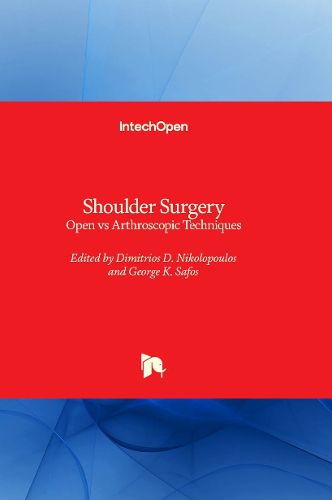Readings Newsletter
Become a Readings Member to make your shopping experience even easier.
Sign in or sign up for free!
You’re not far away from qualifying for FREE standard shipping within Australia
You’ve qualified for FREE standard shipping within Australia
The cart is loading…






This title is printed to order. This book may have been self-published. If so, we cannot guarantee the quality of the content. In the main most books will have gone through the editing process however some may not. We therefore suggest that you be aware of this before ordering this book. If in doubt check either the author or publisher’s details as we are unable to accept any returns unless they are faulty. Please contact us if you have any questions.
Orthopedic practice involves treating a great number of shoulder pathologies, including trauma and sports-related injuries in young adults or arthritis and rotator cuff arthropathies in elderly people. The range of movement (ROM) of the shoulder is 340 degrees, which is the reason for many problems like impingement syndrome, rotator cuff rupture, SLAP (long head of biceps pathology), shoulder fractures, rotator cuff arthropathies, shoulder tumors, and trapezium pathology, all of which are painful conditions of the upper extremity that result in serious discomfort. Shoulder pathology is primarily diagnosed by history and physical examination, but MRIs and CT scans are also very helpful for diagnosis.
The mainstay of treatment involves early identification before the onset of degenerative changes, physical therapy exercises to strengthen the shoulder girdle, and pharmacological interventions to decrease inflammation. Open and arthroscopic techniques have advanced in the last decade, minimizing the possibility of rotator cuff arthropathy and arthritis.
This book provides a comprehensive overview of shoulder pathologies, including shoulder instability, glenoid bone defect, greater tuberosity fractures, lesions of the proximal long head of the biceps tendon, and trapezius myalgia, as well as their different treatments, including open and arthroscopic techniques.
$9.00 standard shipping within Australia
FREE standard shipping within Australia for orders over $100.00
Express & International shipping calculated at checkout
This title is printed to order. This book may have been self-published. If so, we cannot guarantee the quality of the content. In the main most books will have gone through the editing process however some may not. We therefore suggest that you be aware of this before ordering this book. If in doubt check either the author or publisher’s details as we are unable to accept any returns unless they are faulty. Please contact us if you have any questions.
Orthopedic practice involves treating a great number of shoulder pathologies, including trauma and sports-related injuries in young adults or arthritis and rotator cuff arthropathies in elderly people. The range of movement (ROM) of the shoulder is 340 degrees, which is the reason for many problems like impingement syndrome, rotator cuff rupture, SLAP (long head of biceps pathology), shoulder fractures, rotator cuff arthropathies, shoulder tumors, and trapezium pathology, all of which are painful conditions of the upper extremity that result in serious discomfort. Shoulder pathology is primarily diagnosed by history and physical examination, but MRIs and CT scans are also very helpful for diagnosis.
The mainstay of treatment involves early identification before the onset of degenerative changes, physical therapy exercises to strengthen the shoulder girdle, and pharmacological interventions to decrease inflammation. Open and arthroscopic techniques have advanced in the last decade, minimizing the possibility of rotator cuff arthropathy and arthritis.
This book provides a comprehensive overview of shoulder pathologies, including shoulder instability, glenoid bone defect, greater tuberosity fractures, lesions of the proximal long head of the biceps tendon, and trapezius myalgia, as well as their different treatments, including open and arthroscopic techniques.